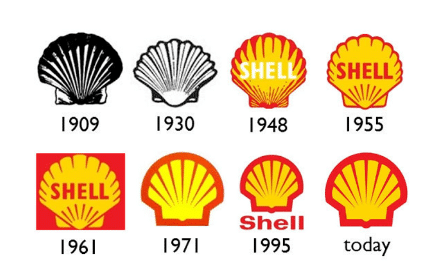Are you ready to take your company to the next level? Then you are ready to start strengthening your brand. What do you start with? A logo!
Logos are literally everywhere. They seem to follow us wherever we go.
In an era with plenty of products to choose from and little time to analyze every brand on the market, the decision of buying a certain product or not is influenced by its logo. It is as obvious as can be that logos play a crucial role in the success of a brand.
Whether you are looking at a brand new logo or a redesign, the possibilities are endless and let’s face it – overwhelming. This is why it’s important to consider important logo design principles. No need to know and apply every single one, but at least a few.
Even when you are not designing, keeping these principles in mind will help you stay focused and make better choices when collaborating with a designer. To make it easier for you, we’ve put together a list of 5 things to pay attention to when designing a logo for your business.
1. Your logo should reflect your brand
That’s right. A logo is the face of a product. A good logo makes the audience instantly think of the brand it represents.
To get brutally honest for a moment. Logo design is not an art. We are not saying it should not look pleasing to the eye, on the contrary, but it is definitely not the sole purpose of a logo. A logo is a strategic business tool, that will distinguish your brand from a sea of other similar products.
As one of our favorite designers Michael Bierut said:
“Some think of logo design as a diving competition, when really it is a swimming competition. It is not about how big of a splash you make, but how long you keep your head above the water.”
2. Your logo should have a timeless design
Nike, a good example for a timeless logo. Created by Carolyn Davidson. Below are the 1978, 1985 and 1995 versions.

Trends come and go, but a good logo will withstand the test of time.
When designing a timeless logo, keep in mind that, in most cases, less is more. Opt for simple and recognizable shapes, don’t use unnecessarily complicated graphical elements, don’t use a visual just because it is trendy or it looks good. The more complex the design, the faster it will date. If your logo includes text, make sure to use classic, well-crafted fonts. Do not exaggerate with decorative fonts. In fact, if you can, use only one font, otherwise, your design will look busy to the eye and hard to remember. However, if you want some variety, use light/bold combinations of the same font, or check our work.

Shell, another logo that defied time, designed by Raymond Loewy.
3. Your logo should be simple
We simply cannot stress that enough. Less is more.
Minimalism has, is, and will always be a good idea. It is more than a trend. Paradoxically, a simple logo will convey more meaning than a complex one. The explanation is… simple (pun intended): simple logos can be interpreted in more ways than complicated ones, so they mean something else to everyone. In this way, everyone gets them, and everyone can relate to them. This is why popular brands have simple logos.

Good brands don’t need to prove that they are good, hence their simple logos.
Another perk of keeping it minimal is that such a logo is easy to manage and scale: it looks good on both a business card and a 6ft banner. Last but not least, an overcomplicated logo looks desperate, it looks like the brand tried too hard, and that doesn’t inspire trust.
4. Your logo should have wisely chosen colors
The color palette is one of the most important parts of a logo. Color choosing should not be a superficial decision. The right colors help you communicate the right ideas to the audience. It sets the tone for how you will be perceived as a brand.
For example, dark blue is associated with trust and reliability, as well as peace. Light blue is more refreshing, it represents ideas and innovation. This is why banks and politicians often use dark blue, while startups tend to use light blue. Red is a very emotionally intense color. It symbolizes energy, this is why a lot of energy drink brands use this color. Red, being a highly visible color, is also used to indicate danger, for this reason, it is used in traffic signs. Purple represents prestige, and green is associated with nature and life.
One interesting thing to note is that the biggest brand rivals use opposite colors in their logos:

Personally, some of our designers enjoy using black and white their designs.
An achromatic color palette provides versatility and timelessness to a logo. It can make a logo look both edgy and elegant. Black is a very bold color, it shows authority and power, while at the same time being less aggressive and emotionally stimulant as other powerful colors.
Some of our designers often use black & white with bright color accents – it draws attention to the vital parts and it makes the overall design pop.
5. Your logo should avoid clichés
New trends appear every now and then. I’m not saying it is bad to keep up with the new fads, but when the same idea is used over and over again, it comes to a point when it’s irrelevant.
Using a generic design defies the sole purpose of the logo – to be recognizable. Like using a globe to represent an international company, or a light-bulb/rocket for a startup. These are not bad ideas, but you should use them only if they represent your brand. Even if you use a popular symbol, bring your own twist to it, make it original, own it.
Before wrapping up, something we say at Enspire is: “logo design is more than just eye candy.”
You can take a look at some logos and other things we’ve created for our clients by checking out our work.
In a nutshell
A logo is a powerful tool to express your values as a brand, to communicate with your potential clients, earn their trust and build a strong connection. Define your brand story, be mindful of solid design principles and create a logo that will take your brand to the next level.
You don’t have to do it alone, either, as our design team would be glad to help. So get in touch!
Related Blog Posts
Podcast: Behind the Story of Enspire
Adam, our CEO/Founder shared about his time with the Peace Corps in Moldova with the My Peace Corps Story podcast. Li...
5 Best Website Hosting Providers for WordPress
In the following guide, we take a look at the 5 best website hosting providers for WordPress. We often get questions ...

